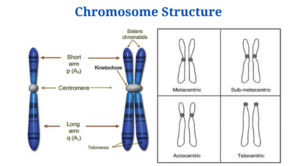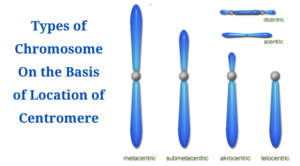Chromosome Definition
- The DNA molecule is bundled into thread-like structures known as chromosomes inside the nucleus of every cell.
- DNA is firmly enclosed numerous times just about the proteins known as histones which maintain the shape of every chromosome.
- Strasburger (1815) was the first to define chromosomes, while Waldeyer (1888) was the first to adopt the name “chromosome.”
- Whenever cells are stained with an appropriate basic dye and observed under a light microscope as during metaphase stage of mitosis, they look like rod-shaped dark stained entities.
Chromosome Structure
- Eukaryotes have numerous big, linear chromosomes that are found in the cell nucleus.
- Every chromosome usually contains a single centromere as well as one or two arms which protrude from it.
- Every chromosome is divided into three segments structurally:
- Pellicle
- Matrix
- Chromonemata
Pellicle
- Pellicle is the external covering that surrounds the chromosome’s material.
- Pellicle is made up of achromatic chemicals and is exceedingly thin.
Matrix
- The chromonemata are found in the chromosome’s ground substance.
- It is made up of non-genic components as well.
Chromonemata
- The chromonemata are two similar spiral pattern coiled threads implanted within the matrix of every chromosome.
- The two chromonemata are indeed tightly coiled together, forming a single thread with a thickness of roughly 800A.
- Every chromonemata is made up of roughly 8 microfibrils, which are each made up of two DNA double helixes.
Underneath a light microscope, the following structural characteristic (apart from the chromomere) can be detected in mitotic metaphase chromosomes:
(1) Chromatid,
(2) Chromonema
(3) Chromomeres
(4) Centromere,
(5) Nucleolar organiser or secondary constriction
(6) Telomerei
(7) Satellite
Centromere
- A tiny structure inside the chromonema defined by a restriction that is known as a permanent component inside the chromosome is the centromere.
- Two chromonemata are now linked at this moment.
- Centromere, kinetochore, or main constriction are all terms for the same thing.
- It separates the chromosome into two parts, or “arms.” The “p arm” known as the short arm of chromosome. The “q arm” known as the long arm of chromosome.
- Its location is fixed for each kind of chromosome plus serves as a distinguishing characteristic.
- The kinetochore has a trilaminar structure in thin electron microscopic sections, with a 10 nm thick dense outside protein aceous layer, a low density central layer, as well as a thick internal lining closely attached to the centromere.
- During cellular division, the chromosomes are connected to spindle threads in this area.
Nucleolar Organiser or Secondary Constriction
- Aside from the primary constriction or the centromere, the chromosome has secondary constriction at any point along its length.
- These constrictions are necessary for detecting specific chromosomes inside a set because they are consistent in their position as well as extent.
- Satellite refers to the chromosome area distant to the secondary constriction, that is, the area between the secondary constriction and the closest telomere.
- Satellite chromosomes, often called as sat-chromosomes, are chromosomes with secondary constrictions.
- The secondary constriction of sat-chromosomes is invariably connected with nucleolus. As a result, secondary constrictions are furthermore known as nucleolus organiser regions (NOR) and sat-chromosomes as nucleolus organiser chromosomes.
How to increase Brain Power – Secrets of Brain Unlocked
Telomeres
- Telomeres are the specialised ends of chromosomes that show physiological differentiation and polarity.
- Because of its polarity, each chromosome extremity prohibits other chromosomal segments from fusing with it. The chromosomal ends are referred to as telomeres.
- Due to the lack of telomeres, if a chromosome breaks, the split ends might fuse with each other.
Types of Chromosome
A. Sex Chromosomes and Autosomes
- There are two types of human chromosomes: autosomes and sex chromosomes.
- Genetic traits associated with a person‘s sex are handed down by the sex chromosomes. The autosomes have the remainder of the genetic information.
- Human cells have 23 pairs of chromosomes, 22 pairs of autosomes, as well as single pair of sex chromosomes, for a total of 46 chromosomes in every cell.
B. Based on the number of centromeres
- Having a single centromere, the organism is monocentric.
- With two centromeres, it is dicentric.
- Polycentric chromosomes containing more than two centromeres
- Without a centromere, the person is acentric. Such chromosomes indicate newly split chromosomal fragments that don’t live for long.
- Diffused or non-located, with an unclear centromere that runs the length of the chromosome.
C. On the Basis of Centromere Location
- Telocentric chromosomes are rod-shaped chromosomes with the centromere in the terminal position, resulting in a chromosome with only one arm.
- Acrocentric chromosomes are also rod-shaped, with the centromere located at the sub-terminus. One arm is extremely long, while the other is extremely short.
- Sub-metacentric chromosomes have a centromere that is somewhat distant from the midpoint, causing the two arms to be not the same.
- Metacentric chromosomes are V-shaped chromosomes in which the centromere is in the middle of the chromosome and the two arms are almost equal.
Chromosomes Function and Importance
- For a given species, the quantity of chromosomes remains stable. As a result, these are crucial in determining the phylogeny and classification of the species.
- Storage of Genetic Code: Chromosomes contain the genetic substance needed by the organism to build up and flourish. DNA molecules are composed of a series of units known as genes. Genes are regions of DNA that code for definite proteins needed by the cell to work properly.
- Sex Determination: Humans contain 23 chromosomal pairs, one of which is the sex chromosome. Males have one X and one Y chromosome, whereas females contain two X chromosomes. The chromosome released down by the male decides the sex of the child. If the X chromosome is released out of the XY chromosome, the child is female; if the Y chromosome is released, the child is male.
- Control of Cell Division: Chromosomes monitor the successful cell division during the mitotic process. The parent cell’s chromosomes ensure that the necessary information is passed on to the daughter cells needed by the cell to grow and develop properly.
- Protein Formation and Storage: Chromosomes direct the sequences of proteins synthesised in human bodies and also keep the order of DNA. Proteins are also contained in the chromosomes’ coiled shape. These proteins that are linked to the DNA aid in the appropriate packaging of the DNA.
Chromosome Citations
- Verma, P. S., & Agrawal, V. K. (2006). Cell Biology, Genetics, Molecular Biology, Evolution & Ecology (1 ed.). S .Chand and company Ltd.
- http://www.yourarticlelibrary.com/biology/chromosomes-structure-functions-and-other-details-about-chromosomes/22946
- https://ghr.nlm.nih.gov/primer/basics/chromosome
- https://www.britannica.com/science/chromosome
Related Posts
- Phylum Porifera: Classification, Characteristics, Examples
- Dissecting Microscope (Stereo Microscope) Definition, Principle, Uses, Parts
- Epithelial Tissue Vs Connective Tissue: Definition, 16+ Differences, Examples
- 29+ Differences Between Arteries and Veins
- 31+ Differences Between DNA and RNA (DNA vs RNA)
- Eukaryotic Cells: Definition, Parts, Structure, Examples
- Centrifugal Force: Definition, Principle, Formula, Examples
- Asexual Vs Sexual Reproduction: Overview, 18+ Differences, Examples
- Glandular Epithelium: Location, Structure, Functions, Examples
- 25+ Differences between Invertebrates and Vertebrates
- Lineweaver–Burk Plot
- Cilia and Flagella: Definition, Structure, Functions and Diagram
- P-value: Definition, Formula, Table and Calculation
- Nucleosome Model of Chromosome
- Northern Blot: Overview, Principle, Procedure and Results


















